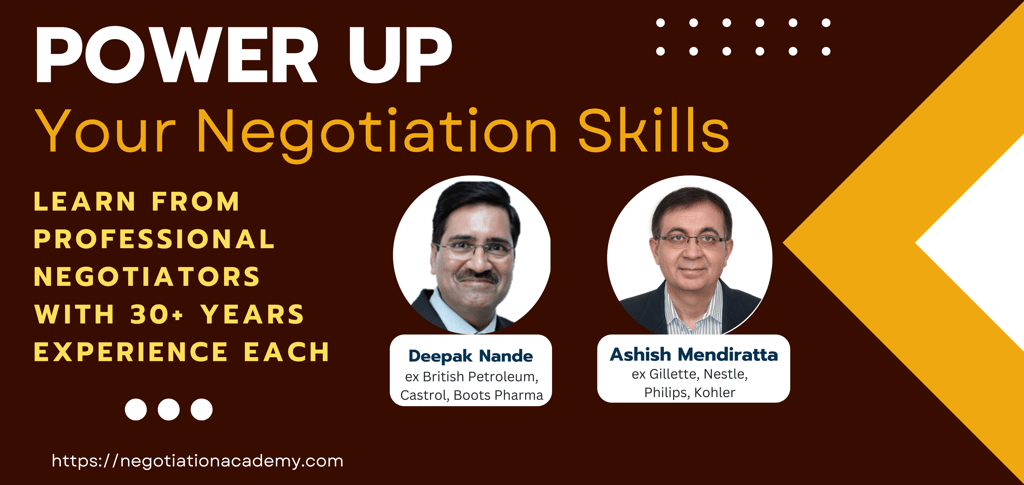The Art and Science of Crafting Supplier Agreements
Discover the art and science of crafting supplier agreements that balance risks, foster trust, and strengthen partnerships. Learn essential clauses, smart contract strategies, and effective negotiation techniques to create fair, concise, and relationship-focused agreements.
CONTRACTS & AGREEMENTSSCIENCE OF NEGOTIATIONART OF NEGOTIATIONNEGOTIATION STRATEGIESRELATIONSHIPSNEGOTIATION SKILLSWIN-WIN NEGOTIATION
Ashish Mendiratta
1/17/20255 min read


Setting the Stage: A Procurement Dilemma
Picture this: You’re in the middle of a tense negotiation with a critical supplier. It’s the final leg before signing a long-term supply agreement for a key raw material essential to your company’s production. The supplier’s representative leans forward and says, “We need to revisit the liability clause; it’s too one-sided. If we agree to this, it exposes us to significant risks.”
At that moment, you’re at a crossroads. How do you respond? Do you dig your heels in, insisting that the clause remains unchanged, or do you find a way to address their concerns without compromising your company’s interests? Your answer determines not just the deal but the foundation of your relationship with this supplier.
Crafting an agreement isn’t merely a transactional task; it’s an opportunity to balance risks, foster trust, and lay the groundwork for a lasting partnership. Let’s dive into the essence of agreements, understand their purpose, and explore the art and science of creating them effectively.
The Essence of an Agreement
At its core, an agreement is more than just a document. It is:
A Blueprint for Collaboration: Agreements outline the expectations, responsibilities, and commitments of both parties. They establish how the partnership will function and evolve.
A Tool for Risk Mitigation: By defining roles, obligations, and contingencies, agreements minimize uncertainties and protect both parties from unforeseen disputes.
A Relationship Builder: When crafted thoughtfully, agreements strengthen trust, ensuring both parties feel secure and respected.
A Conflict Resolution Mechanism: In the event of disagreements, a well-drafted agreement serves as a reference point, guiding both parties toward an equitable resolution.
But what happens when agreements are poorly crafted? Let me share an example.
The Pitfalls of Bad Agreements: A Real-Life Example
A few years ago, a colleague of mine dealt with a poorly drafted agreement that led to a logistical nightmare. The agreement, spanning 40 pages, was filled with complex legal jargon and generic boilerplate clauses. It lacked clarity on critical aspects like delivery timelines, quality standards, and penalties for delays.
When the supplier failed to deliver on time, my colleague’s company suffered significant losses. Attempts to enforce penalties were met with resistance because the clauses were ambiguous and open to interpretation. The relationship soured, and the matter escalated to legal proceedings, draining both time and resources.
This experience underscores a vital lesson: bad agreements are costly, erode trust, and jeopardize partnerships. So how do we avoid these pitfalls?
Crafting Agreements: A Blend of Science and Art
Creating an effective agreement requires a blend of science (the technical, structured elements) and art (the human, relational aspects). Let’s examine both dimensions.
The Science of Crafting Agreements
The science of agreements focuses on ensuring technical soundness, legal compliance, and risk mitigation. Key components include:
Essential Clauses:
Scope and Deliverables: Clearly define what’s being provided, including specifications, timelines, and quality standards.
Payment Terms: Outline pricing, payment schedules, and conditions for adjustments.
Liabilities and Indemnities: Specify responsibilities for damages or losses.
Termination Clauses: Detail conditions under which the agreement can be ended.
Dispute Resolution: Define how conflicts will be resolved (e.g., mediation, arbitration, or litigation).
Boilerplate Clauses: Include standard provisions like confidentiality, force majeure, and governing law, ensuring they are tailored to the context.
Risk Management:
Anticipate potential risks and include clauses to mitigate them (e.g., penalties for non-compliance, force majeure).
Balance obligations to ensure neither party bears disproportionate risk.
Service Level Agreements (SLAs):
Define performance metrics, including quality, timeliness, and compliance.
Include penalties for underperformance and rewards for exceeding expectations to incentivize high standards.
Precision and Clarity:
Avoid ambiguity by using clear, concise language.
Define key terms and avoid excessive legalese.
Structure Based on Risks and Interests:
Tailor the agreement to address the unique risks, concerns, and interests of both parties. A one-size-fits-all approach rarely works.
While these elements are critical, they’re not enough to create a truly effective agreement. This is where the art comes in.
The Art of Crafting Agreements
The art of crafting agreements lies in ensuring they’re perceived as fair, balanced, and relationship-oriented. Here’s how:
Fostering Fairness and Balance:
Strive for an agreement that protects both parties' interests. A one-sided agreement breeds resentment and undermines trust.
Highlight mutual benefits, showing how the agreement aligns with shared goals.
Voice, Tone, and Style:
Use a conversational and collaborative tone that reflects your organization’s values.
Replace legal jargon with plain language to make the agreement accessible to all stakeholders.
Adapt the tone to the context—formal when necessary but always respectful and approachable.
Keeping It Concise:
Remove unnecessary standard clauses and provisions that focus on highly unlikely risks.
Focus on the essentials while leaving room for flexibility.
Reflecting Values and Trust:
Draft agreements that embody your organization’s values (e.g., transparency, fairness, sustainability).
Use a tone that fosters collaboration rather than confrontation.
Building Relationships:
Use the agreement as a tool to reinforce trust and collaboration. For instance, include clauses that encourage joint problem-solving or periodic reviews.
Embracing Technology:
Leverage blockchain and smart contracts for transparency and automation. These technologies can reduce disputes by ensuring clear, tamper-proof records of obligations and transactions.
Equitable Dispute Resolution:
Opt for fair and accessible resolution processes. Avoid private arbitration clauses that limit a party’s rights; instead, propose mechanisms like mediation or public trials for significant disputes.
A Personal Approach: Balancing Interests and Building Trust
In my experience, the most successful agreements stem from a collaborative mindset. Here’s an example from my career:
I once negotiated a supply agreement with a mid-sized vendor who was apprehensive about a stringent penalty clause. Instead of dismissing their concerns, I proposed a graduated penalty structure, where the penalties increased only after repeated delays. This approach addressed our risk while showing empathy for their challenges. The supplier agreed, and the agreement became the foundation of a long-term partnership marked by mutual respect.
Final Thoughts: Crafting Agreements That Work
The process of crafting supplier agreements is both a science and an art. While the science ensures technical soundness and risk mitigation, the art ensures fairness, trust, and collaboration. Here’s a quick recap of the key principles:
Understand the purpose and essence of the agreement.
Avoid the pitfalls of bad agreements by focusing on clarity, balance, and mutual respect.
Blend the science (clauses, risks, liabilities) with the art (empathy, fairness, and relationship-building).
Leverage technology for transparency and efficiency.
Keep agreements concise, humane, and reflective of your values.
The next time you find yourself drafting or negotiating an agreement, remember: it’s not just about protecting your company’s interests. It’s about creating a foundation for collaboration, growth, and shared success. That’s the true art and science of crafting agreements.
Subscribe
Contact:
P2/54 DLF Phase 2 Gurugram 122002
contact@advanchainge.com
+91-9873829286
deepak.nande@advanchainge.com
+91-9820291969



